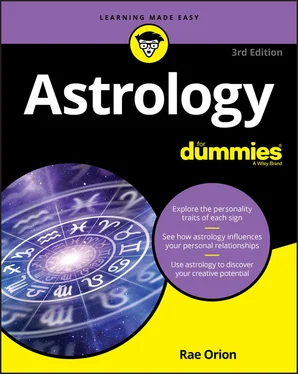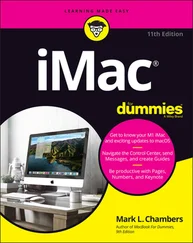1 ...8 9 10 12 13 14 ...25  Considering astrological software
Considering astrological software
 Assessing apps
Assessing apps
 Wandering around the web
Wandering around the web
What could be more fabulously arcane than an astrological chart? Well, lots of things: alchemical sigils, kabalistic diagrams, magical amulets — you name it. But this book isn’t about them. It’s about astrology, which may seem esoteric at first glance but actually is not. That’s because an astrological chart, for all its mysterious-looking symbols and mandala-like shape, has nothing mystical about it. It’s a simple representation of the real world — a picture, in streamlined form, of the solar system at the time of your birth. The interpretation may be complicated and nuanced, but the image itself is straightforward.
To visualize the cosmos as it was when you were born, imagine standing on the Earth at that precise instant. Imagine, too, that you’re facing south and looking at a gigantic clock face that has been superimposed on the sky. To your left, in the nine o’clock position, is the eastern horizon. That’s your Ascendant. If you were born around dawn, that’s where the Sun is. If you were born around midday, your Sun is high in the sky in front of you, near the twelve o’clock mark. To your right, in the three o’clock position, lies the western horizon. If you were born around dusk, that’s where your Sun is. And if you came into this world around midnight, when your part of the world was dark and the other side of the planet was awash in daylight, your Sun can be found near the bottom of your chart, somewhere around the six o’clock spot.
If you happen to know the phase of the Moon at your birth, you can locate it in a similar way. Were you born under a new moon? Then your Moon and Sun are in roughly the same place. Born under a full moon? Then the Sun and Moon are opposite each other — 180° apart. If one is rising, the other is setting.
The point is this: Your natal chart is neither a metaphysical construct nor a mystical diagram. It’s a stylized map of the heavens that shows the Sun, the Moon, and the planets at a precise moment in time from a specific place. The astrologer’s task is to interpret all that information. But first, you have to get an accurate copy of your chart.
Casting Your Chart the Old-Fashioned Way
In the past, before the computer and related technology infiltrated every molecule of human existence, casting a chart was more than a challenge. It was a commitment. It required hours of free time, a fearless attitude towards mathematics, the ability to concentrate on minutiae, and a willingness to grapple with longitude, latitude, standard meridians, local time, daylight saving time, universal time, sidereal time, and a table of proportional logarithms. If you made a mistake — and it was easy to do that, adding when you should have subtracted or copying the wrong numbers from a page entirely covered with rows and columns of numbers — well, you had to start all over again. Most people didn’t have the patience.
I felt differently. I liked staying up late with a pot of tea and all my astrological supplies: a planetary almanac or ephemeris, a heavy atlas, a book of time zones and time changes, a Table of Houses (my battered hardcover — it must be around here somewhere — had a copyright date of 1893), pads of yellow paper, and the special horoscope blanks I bought at a metaphysical bookstore. As I calculated each planetary position and house cusp, drew the symbols of the signs and planets onto the wheel of the chart, figured out the geometrical relationships among the planets, and counted up how many were in fire signs, in earth signs, and so on, the chart — and the person — slowly grew clear in my mind.
That process takes time, and I don’t do it anymore. I use a computer, like every other astrologer. With a computer or a smart phone anyone can generate an accurate chart in less time than it takes to sharpen a pencil. It’s a satisfying form of instant gratification, which is why, as nostalgic as I occasionally feel for those long-ago evenings of computation and revelation, I wouldn’t go back.
In those days, many people who were fascinated by astrology never learned it because they were put off by the math or by the amount of time required. Those issues no longer exist. In the rest of this chapter I tell you how to get an accurate copy of your chart the easy way — via the internet.
First Things First: Gathering the Information You Need
Before you can gaze in wonder at the wonders of your chart, you need the following information:
The month, day, and year of your birth
The place of your birth
The precise time of your birth
Most people know the month, day, year, and place of their birth. If there’s a problem, it’s usually with time. Time matters because it determines your rising sign (see Chapter 11) as well as the house positions for your planets (see Chapter 12). Without a birth time, those components of your chart are unknowable. Having an accurate time is also important if one of your planets changed signs on the day you were born. Is your Moon in Leo or in Virgo? There’s a big difference. That’s why I recommend that you corroborate your birth time through the official record, your birth certificate.
 If you don’t already have a copy of your birth certificate, the most reliable way to get one is to go to the National Center for Health Statistics at
If you don’t already have a copy of your birth certificate, the most reliable way to get one is to go to the National Center for Health Statistics at http://www.cdc.gov/nchs/index.htm and click on “National Vital Statistics System” followed by “How to get a birth, death, marriage, or divorce certificate.” That will send you to a list of U.S. states and territories (plus “foreign or high-seas events,” for those whose birth stories are more dramatic than most). Click on the place of your birth, follow instructions, and be prepared to pay a fee, different in every location.
Once you have your birth certificate, you can be confident that the information on it is more or less correct, although I marvel at the vast number of people who, according to their birth certificates, were born exactly on the hour or half hour. Statistically speaking, there are way too many of us. Still, the time on your birth certificate, rounded off though it may be, has to be considered the gold standard.
If you don’t have a birth certificate, do some sleuthing. Start by asking your mother. But don’t be surprised if her memory of what must surely have been the highlight of her life turns out to be spotty. It’s shocking how many parents can’t remember when their children were born. They know the date — birthdays are easy — but the time is another story. They can’t recall if it was 2:05 or 5:02. They don’t know if it was a.m. or p.m. One mother confessed to me that she wasn’t sure who was born at 10:06 a.m.: her daughter or herself. As every courtroom attorney knows, eyewitness testimony is notoriously unreliable. This is just another instance of that truth.
Dealing with approximate birth times
It can happen, especially if you were born in the United Kingdom, Ireland, Australia, Canada, or India, that a birth certificate will not include a time. In that case, you may have to rely on family legend. Maybe you’ve been told that you were born after breakfast or in the middle of Saturday Night Live . If that is your situation, take the information and run with it. When you’re ready to get your chart, choose a time that corresponds to the legend. Born in the middle of rush hour? Figure that for 6:00 p.m. and carry on.
Читать дальше

 Considering astrological software
Considering astrological software If you don’t already have a copy of your birth certificate, the most reliable way to get one is to go to the National Center for Health Statistics at
If you don’t already have a copy of your birth certificate, the most reliable way to get one is to go to the National Center for Health Statistics at 










